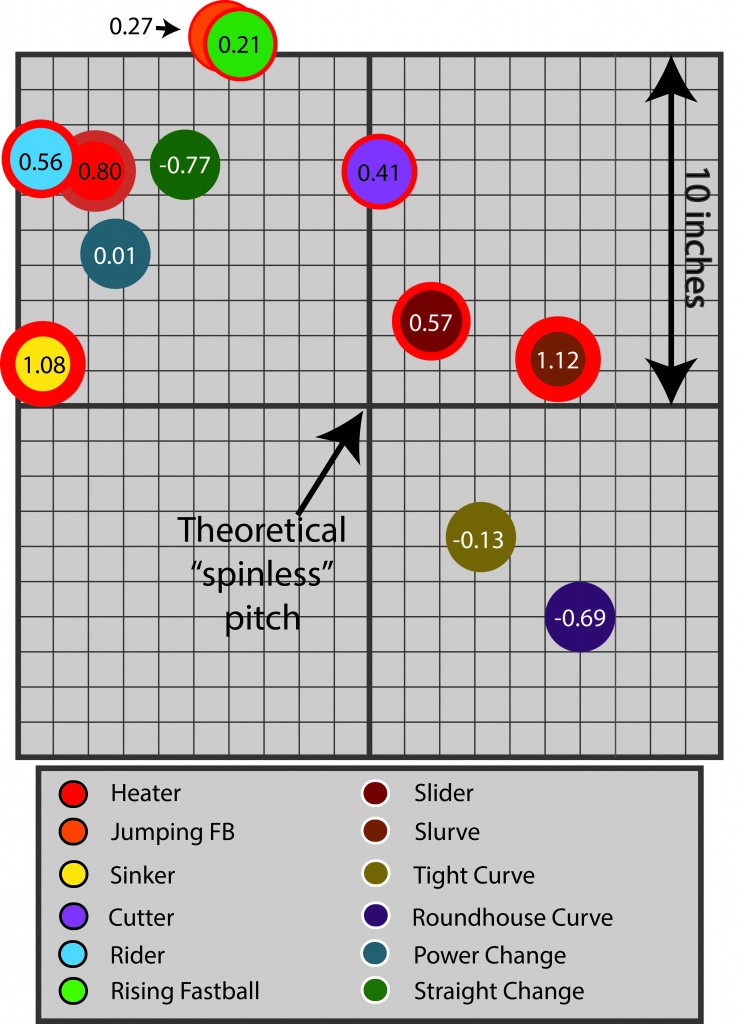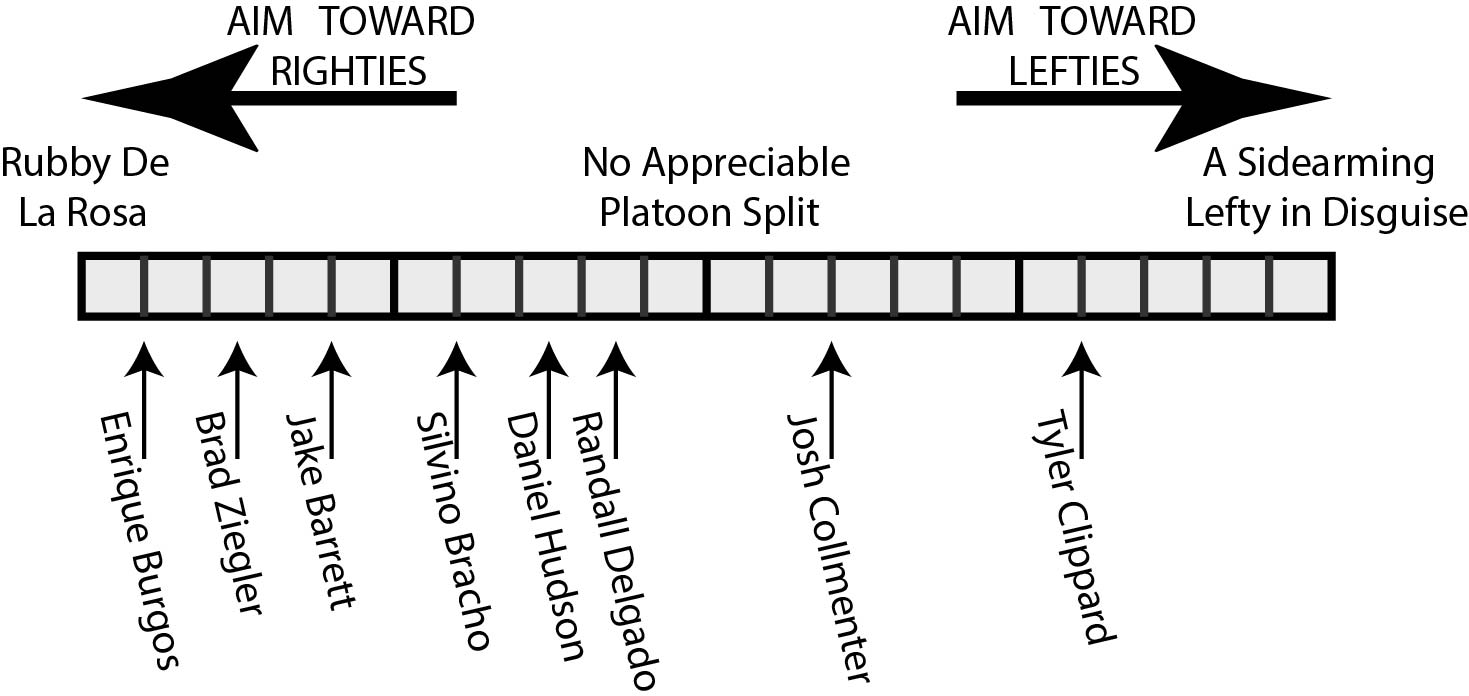The Platoon Continuum for D-backs RHP Relievers
The D-backs will roll with just Andrew Chafin as a lefty out of the ‘pen to start the season, with Brad Ziegler, Daniel Hudson, Tyler Clippard, Randall Delgado, Silvino Bracho and Jake Barrett all throwing from the right side. With Josh Collmenter omitted because of a trip to the DL and Enrique Burgos and Evan Marshall the final cuts at the end of the spring, that trend could continue for much of the year. The good news: some of these guys have a history of effectiveness against lefties. There isn’t really any bad news.
What’s more, we did some work over the offseason on platoon splits for different kinds of pitches, thanks to some excellent work by Max Marchi some years back at The Hardball Times. Marchi only examined righty pitchers, but that suits us just fine. In terms of figuring out which of the D-backs’ righty pitchers should have platoon splits, that research leaves us very well equipped to answer the question we want to answer.
To review, Marchi took a look at all pitches from righties over three seasons, and let the pitches themselves do the talking: although he reported he could have drawn lines elsewhere, the pitches kind of lumped themselves into some standard categories. We don’t even need to use their names. The bottom line is that the data set is enormous, and these platoon splits are very significant.
Here are the two reference points. The first shows the averages (movement and speed) for each of Marchi’s “clumps,” and the second replaces the velocity numbers with a number designating the size of the platoon split. If you’ve got two screens or something like that, you might want to click to blow up one of these images, and keep it handy.
You can think of the platoon split numbers as a “1” being “the difference between quite good and merely average,” or something along those lines. They’re run values per 100 pitches, so :
In the last few months, we’ve kept coming back to the idea that the more vertical a pitch’s movement, the less likely it was to have a significant positive platoon split. But those references have been mostly about fastballs — as a second kind of general principle, it also seems like the slower the pitch, the smaller the platoon split (to the point of being negative, especially with that power change). Maybe that second principle doesn’t seem intuitive, but think of it this way: a small platoon split doesn’t necessarily mean the pitch is very effective against lefties; it could also mean that it’s just not that effective against right-handed hitters. Still, let’s leave it this way:
Principle #1: The more vertical a pitch’s movement, the less susceptible to a positive platoon split.
Principle #2: The more a pitch depends on a slow speed to be effective, the less susceptible to a positive platoon split.
The Platoon Splits of the RHP Relievers
Let’s look at the 6 RHP who made the Opening Day roster, and see what we see, and start to come up with a continuum of sorts, from biggest to smallest platoon split overall. I’m also throwing in Burgos, who might get the first call to the majors, but leaving out Marshall, because the data are strange and he deserves his own post. Collmenter is also below, because of course he has to be. The continuum itself is me guessing, for the most part, trying to take into account these two principles, past splits, and the extent to which each pitcher varies his approach against LHH. And for one last caveat: the velocity numbers in the below charts are release speeds from Brooks Baseball, whereas the numbers in the Marchi chart are unvarnished PITCHf/x speeds (55 feet in front of home plate). So make a small mental adjustment, of about 1 mph for a fastball, etc.
Brad Ziegler
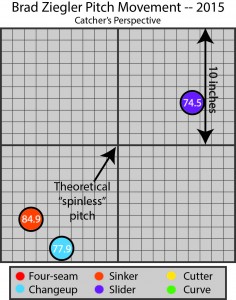 The bullpen’s anchor is also its hardest to gauge in terms of platoon splits from movement; the pitches themselves move as freakishly as the man’s arm. In Marchi’s first article, he actually did have 14 categories, not 12; but for whatever combination of reasons, he had thrown out a category for low-arm-angle pitches by the time he got to platoon splits in a second article.
The bullpen’s anchor is also its hardest to gauge in terms of platoon splits from movement; the pitches themselves move as freakishly as the man’s arm. In Marchi’s first article, he actually did have 14 categories, not 12; but for whatever combination of reasons, he had thrown out a category for low-arm-angle pitches by the time he got to platoon splits in a second article.
In other words, for Ziegler, I can’t do what I set out to do. But we could make some educated guesses, thanks to the two principles. Ziegler’s slider isn’t a whole lot different from other pitchers’ sliders, most closely resembling the “slurve” category above — with a giant platoon split. Ziegler’s other two pitches put the scatter plots on their ear, but both principles tell us the change might have a less positive platoon split than the sinker.
Believe it or not, Ziegler’s slider has been his most effective pitch in terms of slugging against (.065 last year), with his change (.254) more effective than the sinker (.327). That’s been pretty consistent year to year. Sure enough, though, Ziegler does throw his slider far more against RHH than LHH, and the reverse is true with the change. He’s not so weird after all. The main issue: Ziegler does rely heavily on that sinker, throwing it 72.7% of the time to RHH last year, but also throwing it 61.6% of the time to LHH. Predictably, LHH fared better against the sinker, slugging a fairly high .403 last year and doing about as well in other seasons. The change also didn’t do so hot against LHH, and Ziegler might even consider throwing the slider more often to everyone.
Lefties hit .215 against Ziegler last season, which only seems high in context of righties’ .177 mark. It’s the slugging percentage (.350 for LHH, .195 for RHH) that looks hilariously different. Ziegler is an odd case, but it seems like he should be aimed against RHH when possible.
Daniel Hudson
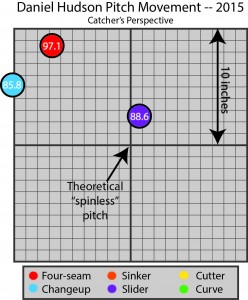 Now, we get to have some fun. Last year, Daniel Hudson had a very pronounced reverse platoon split, which is not something we saw from him as a starter. And, what do you know, his bread and butter pitches got a lot more vertical than they were in the past, fitting Principle #1 quite well.
Now, we get to have some fun. Last year, Daniel Hudson had a very pronounced reverse platoon split, which is not something we saw from him as a starter. And, what do you know, his bread and butter pitches got a lot more vertical than they were in the past, fitting Principle #1 quite well.
Hudson’s four-seam looks very, very similar to the “heater” category from Marchi, which had a very high platoon split of 0.80 runs of value. His change also has almost as much in common with the Marchi “rider” as it does the small-split changeups; but it looks like Principle #2 is carrying the water there. The saving grace: Hudson’s slider has very little vertical movement, which seems to make it a lot less prone to a large split.
Last year, RHH had kind of a field day against that four-seam (.513 SLG), predictably, and still did pretty well against the slider (.367), which is also not that surprising. His changeup’s weird horizontal movement appears to have helped against RHH tremendously, though (.299), supporting the idea that it was more of a “rider” than the Marchi changeup types. Hudson was more of a four-seam/changeup pitcher against LHH, and they still had a pretty good time against the four-seam (.482), although they struggled significantly against the change (.229).
It is super weird that Hudson had a reverse split, and we really would have guessed his four-seam would have had more success against RHH. In addition, Hudson threw at least a couple of sinkers in spring training, and if that has legs, it could give him another weapon that should be more effective against RHH than LHH. Despite the reverse split, then, I would expect Hudson to have a kind of “normal” platoon split this season, and it still seems ideal to aim him at RHH.
Tyler Clippard
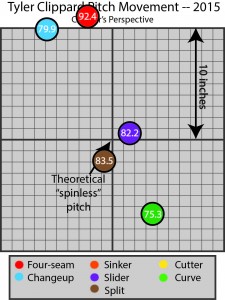 Clippard’s reverse split from last year puts Hudson’s to shame: RHH slugged a robust .411 off the righty, but LHH slugged just .237. As with Hudson, that could partly be the byproduct of being “hidden” from the most difficult LHH. Unlike with Hudson, though, the pitch movement really backs up the story.
Clippard’s reverse split from last year puts Hudson’s to shame: RHH slugged a robust .411 off the righty, but LHH slugged just .237. As with Hudson, that could partly be the byproduct of being “hidden” from the most difficult LHH. Unlike with Hudson, though, the pitch movement really backs up the story.
Clippard broke my graphic here in a few ways, but I don’t resent that. With five pitches, you could almost plot a near-vertical line; most pitchers’ plots are more tilted. The four-seam looks a lot like a “jumping fastball,” but Clippard’s change is so, so vertical and so, so slow that it really doesn’t fit into the Marchi categories at all. Meanwhile, that split comes dangerously close to a theoretical spinless pitch, which is mostly the point anyway.
Not all pitches are equal here — last year, Clippard barely threw that curve, and was mostly a four-seam/change guy against everyone. He threw his slider and split each 7%-8% of the time, and their effectiveness probably has a lot to do with how infrequently they’re used. They don’t really get mixed in more against batters from one side of the plate or the other; what changes is… the change. Clippard threw his changeup 45.3% of the time to lefties last year, more than he threw his actual fastball. Against RHH, he threw it “only” 31.4% of the time.
Taking advantage of both of our Principles, it’s maybe no wonder that Clippard’s change had a hilariously high reverse split last year: RHH slugged .559, whereas LHH had a miniscule .217 despite its high usage. His four-seam had a reverse split that may or may not be sustainable, but the movement does tell us it was unlikely to be very positive anyway; the other two pitches really weren’t thrown enough for us to judge, but based on the Marchi figures, we’d probably guess that the split would not have a (high?) positive split anyway. Simply put: Clippard’s reverse split appears to have legs, and to continue in a significant way.
Randall Delgado
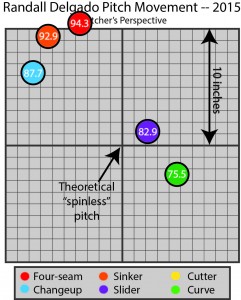 Delgado has never featured a significant split either way, but did go from having a slight reverse split in 2014 to being more effective against RHH in 2015. Delgado went from throwing a small number of curves and sliders to committing to the slider in 2015, and he also featured his sinker more prominently. Both of those things would have pointed in the direction of a more “normal” platoon split.
Delgado has never featured a significant split either way, but did go from having a slight reverse split in 2014 to being more effective against RHH in 2015. Delgado went from throwing a small number of curves and sliders to committing to the slider in 2015, and he also featured his sinker more prominently. Both of those things would have pointed in the direction of a more “normal” platoon split.
It’s pretty much that simple. Delgado threw just 10 curveballs in 2015, and we can probably ignore those; he threw his four-seam about 35% of the time, the slider 25% ish, and the sinker and change about 20% of the time. Against lefties, the slider was worked in a lot less (good!), the change a lot more (great!) and the sinker more, as well (bad!). Last spring, we wanted him to stay away from the sinker in general. But with a more nuanced understanding of how platoon splits for fastballs work now… this makes so much more sense. Delgado should never have been throwing sinkers to lefties, so when he was throwing sinkers over half the time, he was getting torched as a starter. Lefties still slugged a ridiculous .539 against Delgado’s sinker, compared with a tiny .233 against the four-seam (makes sense; look how vertical it is). I don’t understand why this is so hard to understand; once you see it, you can’t un-see it.
The sinker had a lot to do with why Delgado fared worse against lefties than against righties overall. His change did do significantly better against LHH, although that’s partly because it was really pretty bad against RHH. It all makes sense. Against RHH, Delgado can rely on decent results on the fourseam, great results from the sinker and slider, and poor results from the change. Against LHH, Delgado can rely on great results from the four-seam, decent results from the change, and poor results from the sinker. It’s not that complicated.
I’d prefer to not get off track, but it’s hard to suggest how Delgado should be used based on his 2015 pitch mix when there is so obvious a flaw to his approach last year; if he pretty much stopped throwing sinkers to LHH or changeups to RHH, Delgado might end up a reverse split candidate again. As things stand (and as limited spring training data makes it look), he’ll probably swing a little in the “normal” direction.
Silvino Bracho
 We didn’t see this in the majors last year, but in the minors, Bracho has had tremendous success against lefties, who hit just .196 against him in the minors in 2014, and .253 at all levels last season. The thing is: he’s been even more dominant against RHH, to the tune of a .150 SLG in 2015 and .149 SLG in 2014. I’ve held Bracho out as a possible lefty-killer before, and he probably is one, and frequently could be the best bet to face one. But managing a bullpen isn’t just about using the best guy at the best time; it’s about that because games matter, but it’s also about using guys in the best way, so that you get the most overall production.
We didn’t see this in the majors last year, but in the minors, Bracho has had tremendous success against lefties, who hit just .196 against him in the minors in 2014, and .253 at all levels last season. The thing is: he’s been even more dominant against RHH, to the tune of a .150 SLG in 2015 and .149 SLG in 2014. I’ve held Bracho out as a possible lefty-killer before, and he probably is one, and frequently could be the best bet to face one. But managing a bullpen isn’t just about using the best guy at the best time; it’s about that because games matter, but it’s also about using guys in the best way, so that you get the most overall production.
We’ve got a strong example of how vulnerable a fastball/slider guy can be against lefties in Burgos below, and that’s exactly what Bracho is: fastball and slider (his change is more of a 4%-5% pitch). But despite Bracho’s platoon split, he’s a shining example of how helpful this Marchi data can be: Bracho wasn’t vulnerable against LHH in the minors, and given the vertical nature of the four-seam, we seem to be on solid footing expecting that to continue. As little as he throws it, even Bracho’s change looks like a good candidate to have a very small or even reverse split.
The slider… not so much. We don’t have much to go on with PITCHf/x, but for what it’s worth, LHH had a field day against the four-seam and slider. I’m leaning on the minor league splits more than I otherwise would have because of the Marchi data, but we still have to put Bracho solidly in the “normal” column. You wouldn’t avoid LHH with Bracho, and he does look so good that even with a hand tied behind his back, you’d want him out there in a tough spot. He’s definitely at his best against RHH, though, and we can expect Chip Hale to take advantage of that.
Jake Barrett
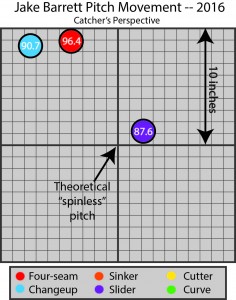 For Barrett, the only vaguely recent PITCHf/x numbers we have to use are the spring training data from this year — and those numbers have been a little inconsistent, which should give us some pause. They don’t seem outlandish, though, and except for the height on the change, they look pretty normal for a RHP reliever.
For Barrett, the only vaguely recent PITCHf/x numbers we have to use are the spring training data from this year — and those numbers have been a little inconsistent, which should give us some pause. They don’t seem outlandish, though, and except for the height on the change, they look pretty normal for a RHP reliever.
We also don’t have a lot of other numbers. Last year was Barrett’s fourth in the system, but it was by far his worst — even though he was splitting his time between Double- and Triple-A almost exactly like the year before. Part of it was control, as a 3.9 BB/9 is high enough to be a liability. But his 8.7 K/9 really should have made up for that — the problem was that he was hit, and frequently. About one hit an inning is a good place to be, and the best pitchers are somewhat lower than that. Barrett was yielding 10.4 hits per 9 innings last year, which is just not good at all.
The problem that Barrett’s 2015 presents is that the numbers are probably just too high. For what it’s worth, it was RHH that destroyed Barrett in 2015 (.877 OPS), but whatever bit him, it didn’t bit him against LHH (.609 OPS). LHH have stayed pretty steady every year, but RHH had an OPS of just in 2014, and in the season that put Barrett on the prospect map in 2013, RHH had an OPS of just .418.
It’s not that I think Barrett definitely showed up this spring back to his old self, exactly, but I do think that if Barrett is to stick in the majors for more than a few weeks, that would be why. Either he’s having tremendous success against RHH again, or he’s not going to be pitching against anyone in the majors after a while. This is the shakiest read that we’re getting from any of the relievers, but best guess is a somewhat normal platoon split, I think.
Enrique Burgos
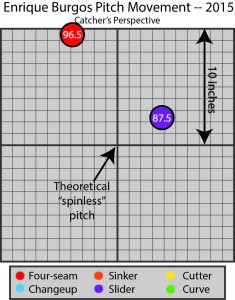 Our least important (for now) guy is also our simplest. Burgos is reportedly working on a splitter, but he won’t be doing that in the majors to start the year — and the information we have is about a four-seam, and about a slider. The fastball has the movement (almost) of a Marchi “jumping fastball,” but the velocity (not quite, especially after the release speed adjustment) of a Marchi “heater.” The slider, on the other hand, has more horizontal movement than most, and it also runs hotter.
Our least important (for now) guy is also our simplest. Burgos is reportedly working on a splitter, but he won’t be doing that in the majors to start the year — and the information we have is about a four-seam, and about a slider. The fastball has the movement (almost) of a Marchi “jumping fastball,” but the velocity (not quite, especially after the release speed adjustment) of a Marchi “heater.” The slider, on the other hand, has more horizontal movement than most, and it also runs hotter.
We only have 27 MLB innings for Burgos, but surprise: lefties ate him for breakfast, lunch, dinner, and midnight snacks. The .293 average is very bad but not horrendous, and the .390 SLG is actually pretty tame. But that’s not the full story: Burgos walked 10 of the 51 lefties he faced, possibly a symptom of erring on the side of balls instead of giving them a hittable pitch.
The numbers and movement suggest that Burgos is not a worst case platoon scenario. Lefties actually did have lots of difficulty of Burgos’s somewhat vertical four-seam, although they completely torched his slider; and it looks like RHH learned they couldn’t hit the slider, leading to sitting on the four-seam, with consequences for Burgos. But he does seem like a candidate to continue leaning in the strong platoon split direction. Burgos is working on a change or splitter at this point, and giving lefties a different look seems like a grand idea. By the time we see him up, he might be a different pitcher. Were he called up tomorrow, though, we’d expect that strong platoon split.
Josh Collmenter
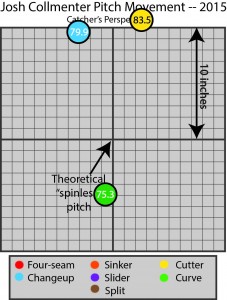 This one really isn’t even funny; in the grand scheme, it’s as freakish as Ziegler, and if you were convinced that Clippard’s scatter plot looked a little turned around, this one could actually have you tipping your head to the right. Part of it is throwing a cutter as his primary pitch, and part of it is that crazy release point. Collmenter has been so good in relief and so different that he could be a candidate to come back in short relief, for a few good reasons. But he is who he is, and we hope he gets well soon.
This one really isn’t even funny; in the grand scheme, it’s as freakish as Ziegler, and if you were convinced that Clippard’s scatter plot looked a little turned around, this one could actually have you tipping your head to the right. Part of it is throwing a cutter as his primary pitch, and part of it is that crazy release point. Collmenter has been so good in relief and so different that he could be a candidate to come back in short relief, for a few good reasons. But he is who he is, and we hope he gets well soon.
Principle #1 was that the more vertical a pitch, the lesser its platoon split. Principle #2 was that slower pitches tended to have smaller splits. Collmenter looks like he was designed in a lab to take advantage of both of those things.
Collmenter’s time as a starter kind of obscures things; he had a .555 SLG against in the rotation, but a happy .365 SLG in relief. Back in his last relief-only season in 2013, he looked similar: a .346 SLG against. Thing is, he had almost no platoon split at all that year, in either direction. Lefties had a higher batting average, but a lower slugging percentage, and that’s kind of how it’s gone since. We have enough of a track record to say that Collmenter isn’t really going to play up against batters from either side, at least not much; and that’s part of his appeal. When Collmenter is not exposed to hitters more than once through the order, it is helpful to get some length out of him; he’s effective that way, although it does mean low-leverage work.
Conclusion: the Reliever Continuum
Here it is:
I might be a little off on Hudson’s platoon split in particular, but he’s about where you might draw the line: to his left, you have guys that you really do want to aim at righties whenever you can, with a little less urgency in Bracho’s case. With Delgado, the team doesn’t stand to benefit too much from any platoon splits. You can’t control who these pitchers will run into, but you can give the pitchers farther to the left the most extreme opportunities, when, say, four RHH are lined up and are unlikely to be replaced. Collmenter is kind of the opposite of Delgado; if you could start him off against a lefty, you might, but a lot like Delgado, his biggest strength is in not having a big split.
The main takeaway, though: more than just being open to having Tyler Clippard throw to lefties, it could be a big mistake if the D-backs don’t try to take those opportunities whenever they come up. If an opponent pinch hits for a RHH to have a LHH face Clippard on occasion? That could be pretty fantastic, too. It’s not out of nowhere — what we know about Clippard’s pitch mix backs that story. Even without the splits in the majors, I probably would have guessed Clippard was at least as far to the right as Collmenter is here, and probably more right. I can’t do the same kind of analysis on LHP without an analysis like Marchi’s, but for what it’s worth, I’d put Andrew Chafin in almost the same exact position as Clippard. Here’s hoping he functions as a second lefty last year in 3-5 PA stints, akin to how Chafin was used last year.
Recent Posts
@ryanpmorrison
 Congrats to @OutfieldGrass24 on a beautiful life, wedding and wife. He deserves all of it (they both do). And I cou… https://t.co/JzJtQ7TgdJ, Jul 23
Congrats to @OutfieldGrass24 on a beautiful life, wedding and wife. He deserves all of it (they both do). And I cou… https://t.co/JzJtQ7TgdJ, Jul 23 Best part of Peralta’s 108 mph fliner over the fence, IMHO: that he got that much leverage despite scooping it out… https://t.co/ivBrl76adF, Apr 08
Best part of Peralta’s 108 mph fliner over the fence, IMHO: that he got that much leverage despite scooping it out… https://t.co/ivBrl76adF, Apr 08 RT @OutfieldGrass24: If you're bored of watching Patrick Corbin get dudes out, you can check out my latest for @TheAthleticAZ. https://t.co/k1DymgY7zO, Apr 04
RT @OutfieldGrass24: If you're bored of watching Patrick Corbin get dudes out, you can check out my latest for @TheAthleticAZ. https://t.co/k1DymgY7zO, Apr 04 Of course, they may have overtaken the league lead for outs on the bases just now, also...
But in 2017, Arizona ha… https://t.co/38MBrr2D4b, Apr 04
Of course, they may have overtaken the league lead for outs on the bases just now, also...
But in 2017, Arizona ha… https://t.co/38MBrr2D4b, Apr 04 Prior to the games today, there had only been 5 steals of 3rd this season (and no CS) in the National League. The… https://t.co/gVVL84vPQ5, Apr 04
Prior to the games today, there had only been 5 steals of 3rd this season (and no CS) in the National League. The… https://t.co/gVVL84vPQ5, Apr 04
Powered by: Web Designers@outfieldgrass24
 RT @DefectorMedia: MLB owners have a lot of power to influence the public’s perception of the CBA proceedings, and they’re willing to… https://t.co/SMs2XAFAtF, Jan 06
RT @DefectorMedia: MLB owners have a lot of power to influence the public’s perception of the CBA proceedings, and they’re willing to… https://t.co/SMs2XAFAtF, Jan 06 Old friend alert https://t.co/DeFNp8fCM8, Jan 06
Old friend alert https://t.co/DeFNp8fCM8, Jan 06 TFW your 114-year old pipes leak under your house right before you try and move 🤦🏻♂️, Jan 05
TFW your 114-year old pipes leak under your house right before you try and move 🤦🏻♂️, Jan 05 Starting 2022 with a frigid dog walk sounds just lovely https://t.co/xoLZSZBpGp, Jan 01
Starting 2022 with a frigid dog walk sounds just lovely https://t.co/xoLZSZBpGp, Jan 01 I’ll never forget seeing Kyle Seager at the Scottsdale Fashion Square one March with his family and thinking “damn,… https://t.co/uapNYdsU2a, Dec 30
I’ll never forget seeing Kyle Seager at the Scottsdale Fashion Square one March with his family and thinking “damn,… https://t.co/uapNYdsU2a, Dec 30
Powered by: Web Designers


